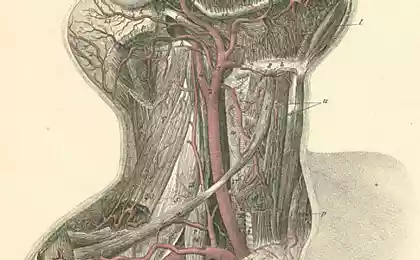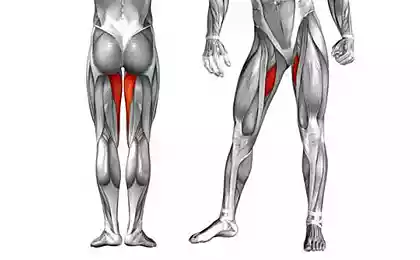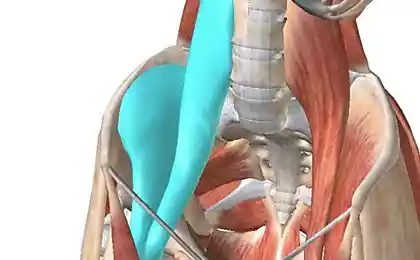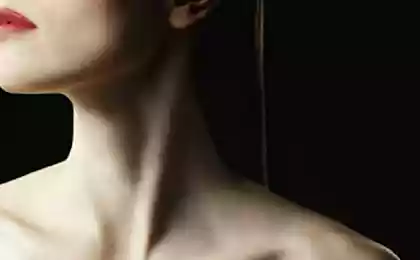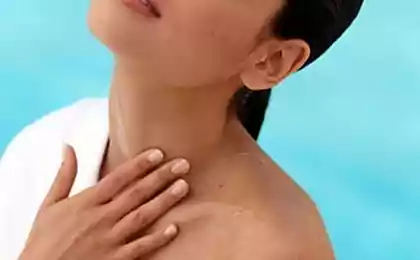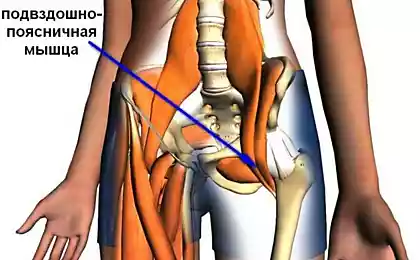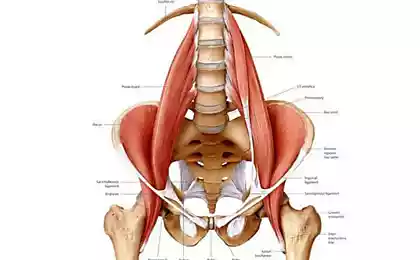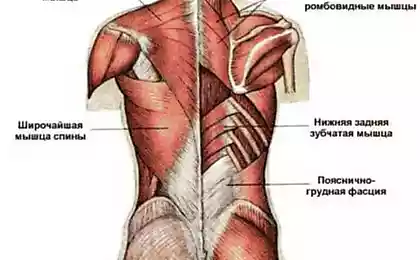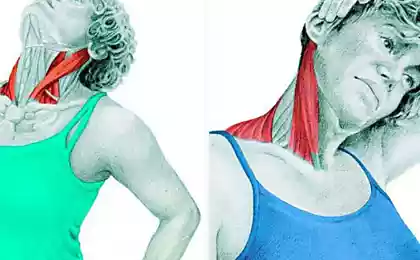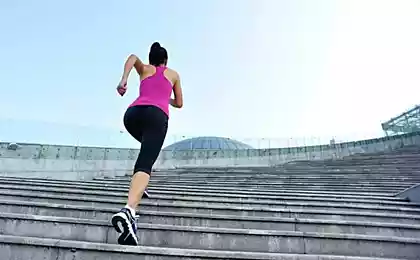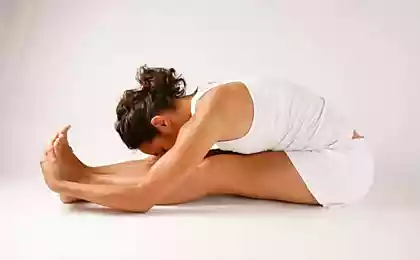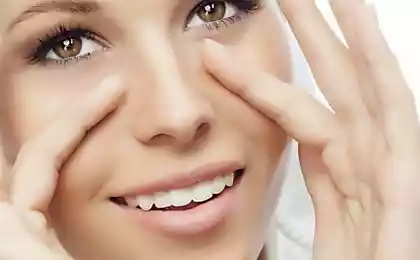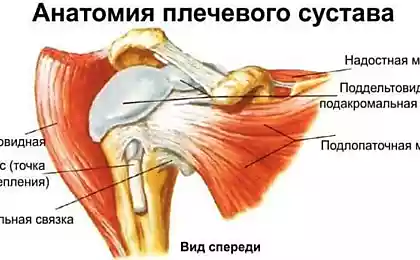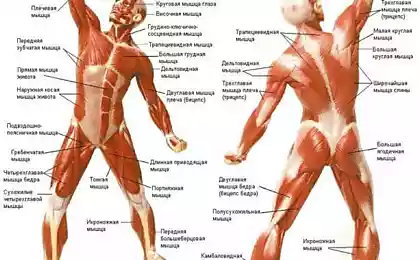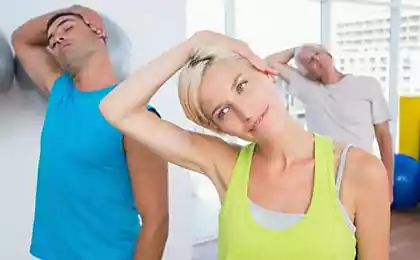997
Subcutaneous muscle of the neck: the secret to younger and healthy neck
Today I will tell about one amazing muscle in our bodies – subcutaneous muscle of the neck (platysma). It is much different from the usual muscles of the body prone to aging and damage.
Subcutaneous muscle of the neck is interesting to us because it determines the appearance of the neck and chin partially. And the neck, as you know, is an important manifestation of the age. In today's article, I will discuss platysma and what to do to strengthen this muscle and keep the proud and beautiful neck to the very elderly.
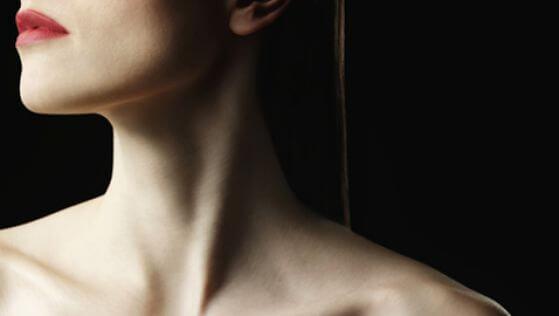
Anatomy of the subcutaneous muscles of the neck.
Subcutaneous neck muscle (platysma) is thin, flat and lies directly under the skin. Starts in the chest region below the collarbone on the surface plate of the pectoral fascia, and passes upwards and medially, occupying almost the entire anterolateral neck area. Remains closed with the arm of a small section having the form of a triangle above the jugular notch of the sternum.
Bundles of the subcutaneous muscles of the neck, rising above the base of the mandible in the face, woven into chewy fascia. Some of the beams subcutaneous muscle of the neck attaches to the muscle, lowering the lower lip, and to the muscle of laughter, weaving in the corner of the mouth.
At the edge of the mandible medial muscle bundles are interwoven with bundles of the same muscle of the opposite side and attach to the edge of the lower jaw; the lateral muscle bundles pass on the face, where it is woven into the fascia of the parotid gland and chewing, reaching the corner of the mouth.

Subcutaneous muscle of the neck (the deep) is not connected with the bone structure and has a tendency to lose elasticity. It also contains a very thin fatty tissue and has less sebaceous glands than the face. The lack of sebaceous glands makes this area very prone to dryness and wrinkle formation.
Individual peculiarities. In some people this muscle is so thin that splits into separate thin bundles. Approximately a quarter of the women initially missing most of the beams of platysma, so the skin of the neck rests mainly on its own elasticity. And a variety of exercises for muscle exercise do not help, because you can't pump what is not there.
Function platysma.
Subcutaneous muscle of the neck — thin and the widest of all facial muscles. This muscle covers the neck and sides, holds and lifts the skin of the neck, largely defining the appearance of the neck front.
Not involved in the normal movements of the head and neck; tenses only with great physical effort and emotional experiences, with a terrible anger, frantic terror, very strong pain. Pulling the skin of the neck, the muscle prevents compression of the saphenous vein; in addition, it can pull down the corner of the mouth, which is important for facial expressions.
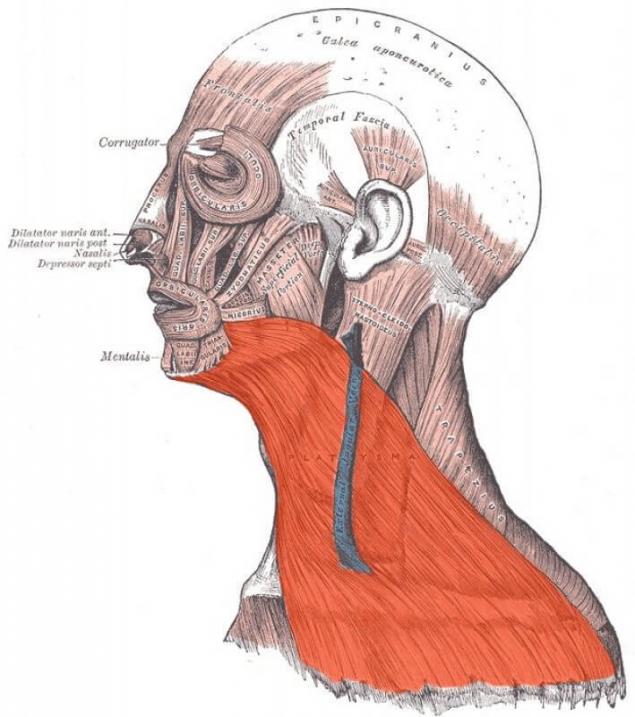
Subcutaneous muscle pulls the skin of the neck, protects the subcutaneous veins from compression and facilitates, thus, the subcutaneous blood circulation in the neck. Weaving in the corner of the mouth, the muscle pulls it downward together with the triangular "muscle dissatisfaction" and, therefore, is involved (sorry, not very helpful) to mimic.
The deep is not involved in the normal movements of the head and neck. She tenses only with great physical effort and emotional experiences, with a terrible anger, frantic terror and intense pain.
In these moments, the muscle pulls the skin of the lower face and angle of mouth to the side and down. On the neck, while reducing it is visible in the form of longitudinal extending in the course of the fibers of rollers (from the bottom up and from outside to inside) is on the horizontal skin folds and wrinkles.
Age-related changes platysma and neck skin.
Neck — not less vulnerable in cosmetic terms, the area of the body. Thin skin and unexpressed subcutaneous fat layer are a prerequisite for rapid dehydration. The lack of a rich network of small vessels and slow blood circulation, little activity of the muscles of the anterior surface of the neck helps you lose their tone and atrophy of tissues, early ptosis of the skin, forming longitudinal and transverse folds, bands, and rings of wrinkles, which deepen and increase.
The ligaments between the skin and muscle platysma very dense, so there is no any noticeable slip between these tissues. Indeed, muscle platysma has the same embryologic origin as the skin. They are subjected to aging process at the same time, which is supported by their close interaction.
Gradually the front of the neck there are deep transverse folds, the wrinkled skin at the bottom edge of face and chin rapidly loses tone, stretches and begins to SAG.
For appearance this area rests with subcutaneous muscle of the neck — deep. With age it loses its elasticity, the edges of the muscles in the midline may differ, and then on the neck are formed longitudinal bands ("Turkey neck"), as well as increased neck-chin angle.
Subcutaneous neck muscle of a young man is a muscle the blade and forms almost a right angle with the horizontal part, it is placed at the level of rizorius and almost fills the space below the collarbone.
During aging the front edges of all the muscles of platysma shifted forward to the edge of subcutaneous neck muscles, and their link to the middle line has already been studied by Connell and Golom. It must be remembered that the young people they are in front, and their condition depends on the severity of ligament platysma, which can be more or less visible, depending on the formation of the angle between the neck and chin.
With aging the skin is the destruction of elastin and collagen, it loses its elasticity, which leads to the manifestation of "gravitational ptosis" – a soft tissue SAG under the action of gravity.
Age-related degenerative changes in the muscle tissue primarily manifested by weakness of subcutaneous neck muscles (muscle fibers which are located in a thin layer beneath the skin the entire front of the neck). But change it more often manifest themselves by the formation of double chin and sagging skin on the type of "Turkey neck".
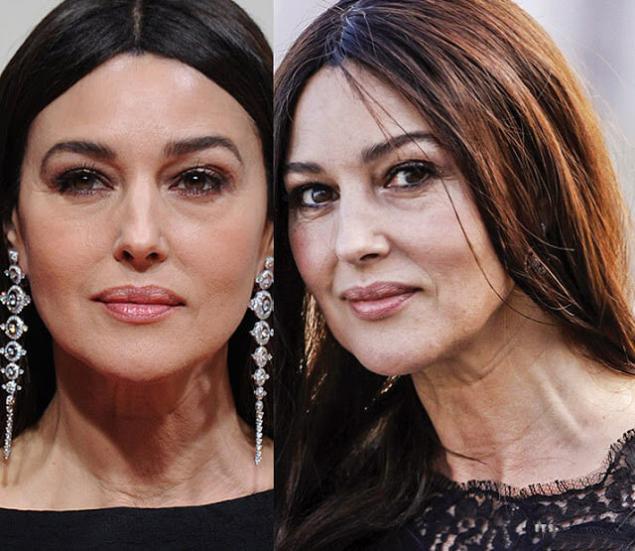
For those who want specific features, please. Signs young neck:
1. A clear outline of the lower jaw
2. In the retraction of the hyoid region
3. Visible contouring of the thyroid cartilage ("Adam's Apple", different manifestations, depending on gender, approx. transl.)
4. Visible contouring of the edge of sternocleidomastoid muscle
5. SM – SM 90 ° angle. (the angle between podvodburstroy line (SubMental line) and the front edge of the sternocleidomastoid muscle (SternocleidoMastoid border)
6. Neck-chin angle (cervicomental angle) from 105 to 120 degrees.
Fat deformation region platysma.
In the skin of the neck, the blood circulates more slowly than the face. The layer of subcutaneous fat is very thin. Even a small excess of adipose tissue is distributed unevenly here.
Chin-neck area related to "fat traps". Features of its structure such that it accumulates fat in the first place, and for weight loss is consumed in the last. Of course, overweight and obesity are important factors leading to the emergence of a double chin, but it can be formed when there is no problem with the extra weight.
With age there is an accumulation of adipose tissue in the lower parts of the cheeks and chin area. The middle (medial) edge of the subcutaneous muscles of the neck (deep) reflex compensate for age-related changes and, in most cases, thicken, and sides of her remain relaxed. The result is a pronounced medial edge of the muscle, along which in the course of the fibres on the neck appear bands.
The rings of Venus and the neck of Cleopatra.
The divided edges of the muscles of the neck especially well observed from thin people with muscle tension of the neck and a moderate head rotation to the side. The transverse groove on the women's necks gallant French dubbed the ring of Venus. (not to be confused with ozherelem Venus – spots, a symptom of syphilis).
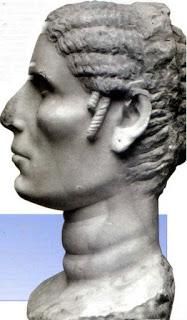
A possible variant of hereditary ringed neck, also called "neck of Cleopatra", and skin-fat folds in the country, no less romantic name of "rings of Venus".
In this case they do not pass with age, and remain for life, although modified compared to the infant Pei-stocking. Such folds are similar, rather, on the small ring. Judging by the mummies, women of the dynasty of the Ptolemies was an increase of about 1.5 m and not skinny.
Coins and busts of Cleopatra show fat deposits around the neck — of the statues they are called "venerini rings". Perhaps the artists emphasized their full life of their models, but according to some experts, in this case it is not pure symbolism. It seems that the neck of the Queen was stout. In some images, striking longish hooked nose, sharp protruding chin.
What to do? Posture, facial expressions (emotions), hormones.
And then exercise. Without posture correction exercises to do makes no sense, also there is no point in exercises if you are genetically weak platysma. (cosmetic surgery I do not discuss)
Posture.
American actress Katharine Hepburn who looked 70 years on forty incomplete without plastics, advised: to avoid folds on the neck, often look at the stars! When you tilt your head, stretched thin and wide subcutaneous muscle (the deep) that goes from the clavicle to lower jaw. This is a great exercise for her!
Habit to slouch, to walk with my head down can cause poor circulation in the neck, fat deposition in the chin region. Also makes your double chin more noticeable.
First of all, in the appearance of wrinkles is to blame excessive weakness of subcutaneous neck muscles, but one of the main causes of deterioration of the skin of the neck is bad posture. Because in real life we often look at their feet, and not in the sky, works at platysma virtually no. And from the forced inactivity it weakens, becomes listless, stops sagging and tighten the skin.
Unhealthy facial expressions (the emotional status)
The corners of the mouth – your attitude to life. Habitual emotions, with age, harden in the face. With the constant expression of negativity, disgust (drooping mouth corners), the expression freezes on her face and contributes to the deterioration of platysma.
Relaxation of muscles, lowering the angle of the mouth, at minimum dosage gives effective result in lifting of the corners of the lips and changes facial expression to a more positive. And correction of the subcutaneous muscles of the neck, platysma able to redistribute muscle activity and volumes that will be expressed in the lifting not only of the lower third, but average.
In performing this correction, it should be remembered that the effect is not only due to the relaxation of muscles-depressors, but also due to the activation of the antagonist muscles — levatores middle third of the face.

Do not hurt the subcutaneous muscle of the neck.
Beware overextend platysma during training in the gym! When you lift weights or perform exercises that exert tension on these muscles, they in turn cause the skin to fall with them.
When you see that happening, then pay attention to what you are doing in this moment and what you can do to rectify the situation muscles. The best way to avoid tension in subcutaneous muscles of the neck is to know about their condition during exercise.
Do their exercises possibly in front of a mirror and every time you see that the neck muscles are constricted or tight, stop. Relax your muscles. Then continue the exercise, not allowing your neck to strain as in previous times.
Do not massage a subcutaneous muscle of the neck. Massaging the neck is fraught with the tension of the skin. Only exercise subcutaneous muscles of the neck can greatly improve neck skin without stretching and allow to get rid of wrinkles on the neck. Exercise will make your neck skin tighter, firmer and smoother, improving the blood circulation in the lower layers of its nutrition and respiration. Stronger she will become and subcutaneous muscle.
Hormonal imbalance.
In the first place – problems with the thyroid gland. Hormonal disorders, hormonal changes at menopause contribute to the accelerated formation of fatty deposits in the neck region.
In hypothyroidism low concentration of thyroid hormones contributes to obesity and formation of double chin. Disease, accompanied by a significant increase in the size of the thyroid ("goiter") visually enhance the front of the neck.
Exercises for subcutaneous muscles of the neck.
Exercise 1.
Exercise subcutaneous muscles of the neck and other facial muscles, is best done in a static mode. Maximum muscle is strained, the voltage is about 6 seconds, followed by her complete relaxation before the next voltage.
Look at the photo above and imagine where you have stored the subcutaneous muscle of the neck. Straining this muscle, you can feel its length to the pectoral muscles, and its width almost up to his armpits.
To reduce the subcutaneous muscle, you must effort to simultaneously lower the lower lip and chin. Cervical muscle when a strong voltage is clearly visible, as if through the skin stood out vertical ribs. To be afraid of "ribs" should not – their maximum sharpness at the time of exercise need to achieve.
Try to make this effort possible. To reduce the subcutaneous muscle of the neck more, you can bend the bottom lip. Your face should acquire a fearful expression.
Relax your neck and try to cut it down, helping the tension mentally. The tension of the muscle should be felt across the front of the neck and the top of your chest to the collarbone and armpits. Increasing voltage will also contribute to reduction simultaneously with the breath.
Rest for a while. Did you feel tension on the back of the neck? If felt, it is the result of incorrect head position or poor posture. Posture can and should be purposefully corrected, and now just find such a head position in which the strong muscles of the head and neck are not tense when you forcefully reduce the subcutaneous muscle of the neck.
The next suspense will notice the formation of wrinkles on the face and the shape of your mouth, changing which you can achieve the disappearance of all emerging folds. Remember how to open his mouth to with voltage of the subcutaneous muscles on the cheeks, near the corners of the mouth or under the lower lip formed folds.
For a full muscle exercise it is also important to fully relax her after each voltage. Learn to feel the relaxation of the subcutaneous muscle extending from the chest to the chin, lower lip and corners of the mouth.
Exercise 2.
The first time during exercise you will need a mirror. You may need, changing the shape of the mouth when the muscle tension, to find that in which some of the mouth, under the lower lip or on the cheeks does not create new folds.
It is also important to clearly distinguish the voltage of the subcutaneous muscle from the possible tension in the muscles of the lower jaw, strong muscles of the head and neck are in the back. Correct head position (head up) will help you keep these muscles relaxed.
During inhalation, helping the muscle to shrink mentally, pull down the lower lip and lower jaw so that the tension in subcutaneous muscles of the neck was the highest and "ribs" clearly evident on his neck.
Count about 6 seconds and completely relax your neck simultaneously with an exhalation.
Repeat 4-5 times with intervals of 2-3 seconds between the voltages.
You must learn to feel not only the tension but also relaxing the subcutaneous muscles of the neck: try after each approach to feel calm, which moves from the bottom to the chin, lower lip and corners of the mouth. During exercise, carefully observe his face: all the other facial muscles must remain relaxed, the person does not have to be new or deepening existing creases.
With the improvement of technology you will be able to perform lifting subcutaneous muscles of the neck without the formation of pronounced vertical folds. You just learn more subtly to feel subcutaneous muscle and manage individual plots.
During exercise follow the mouth. Do not lower the corners of the lips is the cause of the formation of additional wrinkles. It is better to keep your mouth slightly stretched in a half-smile. Economy option: hands in fists, fix subcutaneous muscle of the neck near the collarbones. And muscle is trained, and not very scary for the people around it.
The easiest way to pump up the subcutaneous muscle and to remove the sagging neck is to learn the game on wind instruments. Look at the photo of trumpeters and saxophonists with the skin of the neck they have no problems.

Exercise 3.
Exercise training for subcutaneous muscles of the neck. Subcutaneous muscle pulls the skin of the neck, protects the subcutaneous veins from compression and thus facilitates the blood circulation in the neck. With the weakening of muscle tone on the skin formed wrinkles that encircle the neck.
When sagging muscle fibers appear under the chin with vertical wrinkles, as well as this muscle is woven into the skin of the corners of the mouth to pull it, the wrinkles are noticed on the chin and cheeks. To improve the tone of the neck muscles the necessary exercise.
These exercises are head turns, head tilts forward, backward, sideways, rotation and other Necessary special exercises: 1) bend your head forward and produce the pressing of hands on the skin of the anterior surface of the chest at the level II —III ribs. Then, taking a breath and fixing his skin to the ribs, and discharged slowly raise the head back, thus causing the tension in subcutaneous muscles of the neck.
Breathing out, the head is installed in vertical position. The entire cycle of movements is repeated 3 — 6 times; 2) through the nose slowly inhale and produce, widely opening the mouth, head to the limit recline back.
Then, keeping the laid back head position and making it through the nose exhale slowly, mouth closed, causing the lower jaw to the upper. Returning the head to a vertical position, resting 2 — 3 C. the Exercise is repeated 36 times.
Exercise 4. Simhasana — the lion Pose

When protruding tongue lifts the hyoid bone; aktiviziruyutsya digestive system, intrabitation muscle, nadpochechnaja muscle, the rectus abdominis, the pelvic floor muscles and the muscles that attach to the sternum.
A strong exhalation ("the lion's roar") activates the diaphragm, pelvic floor muscles and the muscles that control the vocal cords. This reduces also the subcutaneous muscle of the neck, upper and medial rectus muscles of the eye (rotates the eye inward and upward).
Simhasana stimulates a lot of muscle that gets little attention. But the limitation of motion of the cervical spine is often attributable to a stiffening of the regions of the tongue and jaw.
In addition, the simhasana has a tonic effect on subcutaneous muscle of the neck that will give a good cosmetic effect. In addition, the conscious contraction of these muscles on the exhale helps them to relax during inhalation.
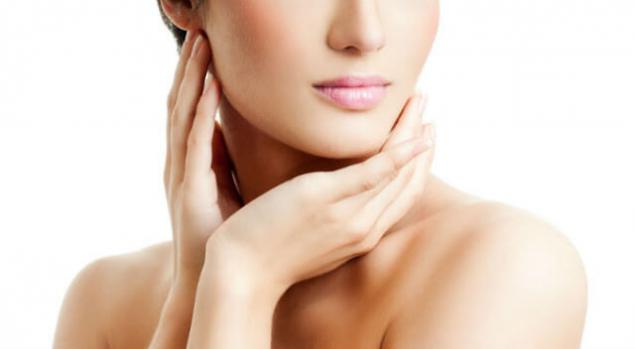
Different exercises.
Pull the lips tightly pressed corners of the mouth to the teeth. Having counted to 10, slowly start to pull the lips to the center. Now slide the compressed lips for 5 times left and right. Feel how tense the muscles of the neck and chin? You can now relax and spend the palms face upward – this will help relieve tension.
Try to open your mouth and say the long "Ah", not stretching and not shrinking lips.Happened? Now figure in mind to 15 and without moving the jaws slowly somknite lips. You will not be able to make it to the end – mouth remains slightly ajar. You need to stay in this position for a count of 10. Then you can relax. Once the exercise is mastered well, repeat it 3 times a day.
Close the jaws tightly, stretch as much as possible lower lip. Count to 15. Subcutaneous muscle of the neck – deep in this, too, will tighten! Relax, and then try to simultaneously stretch both lips at once. Try again.
Try to whistle 5-10 seconds, tightly clutching the corners of the mouth to the teeth.
Royal gymnastics: exercises for pain in the back
Point hand massage to reduce appetite and not only
Then inflate your cheeks as much as possible, close your mouth and start to move the air in a circle – the left cheek on the upper lip to the right cheek and from under the lower lip right to the left cheek. Then slightly tilt your head back and begin to gently blow out air. Imagine if blow off a speck of dust. Repeat 3-5 times.
Put elbows on the table, and, with his lips a pipe, tighten the jaw. You need to move clasped fingers palms upward along the jaw on both sides of the face. Do not forget lightly press on Apraksina muscles.
Then you need to just massage the cheeks toward the mouth. Towards the end of the need to squeeze his cheeks with his hands and count to 10. Relax. Several times clap hands over his face and neck.published
Author: Andrey Blueskin
P. S. And remember, only by changing their consumption — together we change the world! ©
Source: www.beloveshkin.com/2016/07/podkozhnaya-myshca-shei-plyatizma-sekret-molodoj-i-zdorovoj-shei.html
Subcutaneous muscle of the neck is interesting to us because it determines the appearance of the neck and chin partially. And the neck, as you know, is an important manifestation of the age. In today's article, I will discuss platysma and what to do to strengthen this muscle and keep the proud and beautiful neck to the very elderly.

Anatomy of the subcutaneous muscles of the neck.
Subcutaneous neck muscle (platysma) is thin, flat and lies directly under the skin. Starts in the chest region below the collarbone on the surface plate of the pectoral fascia, and passes upwards and medially, occupying almost the entire anterolateral neck area. Remains closed with the arm of a small section having the form of a triangle above the jugular notch of the sternum.
Bundles of the subcutaneous muscles of the neck, rising above the base of the mandible in the face, woven into chewy fascia. Some of the beams subcutaneous muscle of the neck attaches to the muscle, lowering the lower lip, and to the muscle of laughter, weaving in the corner of the mouth.
At the edge of the mandible medial muscle bundles are interwoven with bundles of the same muscle of the opposite side and attach to the edge of the lower jaw; the lateral muscle bundles pass on the face, where it is woven into the fascia of the parotid gland and chewing, reaching the corner of the mouth.

Subcutaneous muscle of the neck (the deep) is not connected with the bone structure and has a tendency to lose elasticity. It also contains a very thin fatty tissue and has less sebaceous glands than the face. The lack of sebaceous glands makes this area very prone to dryness and wrinkle formation.
Individual peculiarities. In some people this muscle is so thin that splits into separate thin bundles. Approximately a quarter of the women initially missing most of the beams of platysma, so the skin of the neck rests mainly on its own elasticity. And a variety of exercises for muscle exercise do not help, because you can't pump what is not there.
Function platysma.
Subcutaneous muscle of the neck — thin and the widest of all facial muscles. This muscle covers the neck and sides, holds and lifts the skin of the neck, largely defining the appearance of the neck front.
Not involved in the normal movements of the head and neck; tenses only with great physical effort and emotional experiences, with a terrible anger, frantic terror, very strong pain. Pulling the skin of the neck, the muscle prevents compression of the saphenous vein; in addition, it can pull down the corner of the mouth, which is important for facial expressions.

Subcutaneous muscle pulls the skin of the neck, protects the subcutaneous veins from compression and facilitates, thus, the subcutaneous blood circulation in the neck. Weaving in the corner of the mouth, the muscle pulls it downward together with the triangular "muscle dissatisfaction" and, therefore, is involved (sorry, not very helpful) to mimic.
The deep is not involved in the normal movements of the head and neck. She tenses only with great physical effort and emotional experiences, with a terrible anger, frantic terror and intense pain.
In these moments, the muscle pulls the skin of the lower face and angle of mouth to the side and down. On the neck, while reducing it is visible in the form of longitudinal extending in the course of the fibers of rollers (from the bottom up and from outside to inside) is on the horizontal skin folds and wrinkles.
Age-related changes platysma and neck skin.
Neck — not less vulnerable in cosmetic terms, the area of the body. Thin skin and unexpressed subcutaneous fat layer are a prerequisite for rapid dehydration. The lack of a rich network of small vessels and slow blood circulation, little activity of the muscles of the anterior surface of the neck helps you lose their tone and atrophy of tissues, early ptosis of the skin, forming longitudinal and transverse folds, bands, and rings of wrinkles, which deepen and increase.
The ligaments between the skin and muscle platysma very dense, so there is no any noticeable slip between these tissues. Indeed, muscle platysma has the same embryologic origin as the skin. They are subjected to aging process at the same time, which is supported by their close interaction.
Gradually the front of the neck there are deep transverse folds, the wrinkled skin at the bottom edge of face and chin rapidly loses tone, stretches and begins to SAG.
For appearance this area rests with subcutaneous muscle of the neck — deep. With age it loses its elasticity, the edges of the muscles in the midline may differ, and then on the neck are formed longitudinal bands ("Turkey neck"), as well as increased neck-chin angle.
Subcutaneous neck muscle of a young man is a muscle the blade and forms almost a right angle with the horizontal part, it is placed at the level of rizorius and almost fills the space below the collarbone.
During aging the front edges of all the muscles of platysma shifted forward to the edge of subcutaneous neck muscles, and their link to the middle line has already been studied by Connell and Golom. It must be remembered that the young people they are in front, and their condition depends on the severity of ligament platysma, which can be more or less visible, depending on the formation of the angle between the neck and chin.
With aging the skin is the destruction of elastin and collagen, it loses its elasticity, which leads to the manifestation of "gravitational ptosis" – a soft tissue SAG under the action of gravity.
Age-related degenerative changes in the muscle tissue primarily manifested by weakness of subcutaneous neck muscles (muscle fibers which are located in a thin layer beneath the skin the entire front of the neck). But change it more often manifest themselves by the formation of double chin and sagging skin on the type of "Turkey neck".

For those who want specific features, please. Signs young neck:
1. A clear outline of the lower jaw
2. In the retraction of the hyoid region
3. Visible contouring of the thyroid cartilage ("Adam's Apple", different manifestations, depending on gender, approx. transl.)
4. Visible contouring of the edge of sternocleidomastoid muscle
5. SM – SM 90 ° angle. (the angle between podvodburstroy line (SubMental line) and the front edge of the sternocleidomastoid muscle (SternocleidoMastoid border)
6. Neck-chin angle (cervicomental angle) from 105 to 120 degrees.
Fat deformation region platysma.
In the skin of the neck, the blood circulates more slowly than the face. The layer of subcutaneous fat is very thin. Even a small excess of adipose tissue is distributed unevenly here.
Chin-neck area related to "fat traps". Features of its structure such that it accumulates fat in the first place, and for weight loss is consumed in the last. Of course, overweight and obesity are important factors leading to the emergence of a double chin, but it can be formed when there is no problem with the extra weight.
With age there is an accumulation of adipose tissue in the lower parts of the cheeks and chin area. The middle (medial) edge of the subcutaneous muscles of the neck (deep) reflex compensate for age-related changes and, in most cases, thicken, and sides of her remain relaxed. The result is a pronounced medial edge of the muscle, along which in the course of the fibres on the neck appear bands.
The rings of Venus and the neck of Cleopatra.
The divided edges of the muscles of the neck especially well observed from thin people with muscle tension of the neck and a moderate head rotation to the side. The transverse groove on the women's necks gallant French dubbed the ring of Venus. (not to be confused with ozherelem Venus – spots, a symptom of syphilis).

A possible variant of hereditary ringed neck, also called "neck of Cleopatra", and skin-fat folds in the country, no less romantic name of "rings of Venus".
In this case they do not pass with age, and remain for life, although modified compared to the infant Pei-stocking. Such folds are similar, rather, on the small ring. Judging by the mummies, women of the dynasty of the Ptolemies was an increase of about 1.5 m and not skinny.
Coins and busts of Cleopatra show fat deposits around the neck — of the statues they are called "venerini rings". Perhaps the artists emphasized their full life of their models, but according to some experts, in this case it is not pure symbolism. It seems that the neck of the Queen was stout. In some images, striking longish hooked nose, sharp protruding chin.
What to do? Posture, facial expressions (emotions), hormones.
And then exercise. Without posture correction exercises to do makes no sense, also there is no point in exercises if you are genetically weak platysma. (cosmetic surgery I do not discuss)
Posture.
American actress Katharine Hepburn who looked 70 years on forty incomplete without plastics, advised: to avoid folds on the neck, often look at the stars! When you tilt your head, stretched thin and wide subcutaneous muscle (the deep) that goes from the clavicle to lower jaw. This is a great exercise for her!
Habit to slouch, to walk with my head down can cause poor circulation in the neck, fat deposition in the chin region. Also makes your double chin more noticeable.
First of all, in the appearance of wrinkles is to blame excessive weakness of subcutaneous neck muscles, but one of the main causes of deterioration of the skin of the neck is bad posture. Because in real life we often look at their feet, and not in the sky, works at platysma virtually no. And from the forced inactivity it weakens, becomes listless, stops sagging and tighten the skin.
Unhealthy facial expressions (the emotional status)
The corners of the mouth – your attitude to life. Habitual emotions, with age, harden in the face. With the constant expression of negativity, disgust (drooping mouth corners), the expression freezes on her face and contributes to the deterioration of platysma.
Relaxation of muscles, lowering the angle of the mouth, at minimum dosage gives effective result in lifting of the corners of the lips and changes facial expression to a more positive. And correction of the subcutaneous muscles of the neck, platysma able to redistribute muscle activity and volumes that will be expressed in the lifting not only of the lower third, but average.
In performing this correction, it should be remembered that the effect is not only due to the relaxation of muscles-depressors, but also due to the activation of the antagonist muscles — levatores middle third of the face.

Do not hurt the subcutaneous muscle of the neck.
Beware overextend platysma during training in the gym! When you lift weights or perform exercises that exert tension on these muscles, they in turn cause the skin to fall with them.
When you see that happening, then pay attention to what you are doing in this moment and what you can do to rectify the situation muscles. The best way to avoid tension in subcutaneous muscles of the neck is to know about their condition during exercise.
Do their exercises possibly in front of a mirror and every time you see that the neck muscles are constricted or tight, stop. Relax your muscles. Then continue the exercise, not allowing your neck to strain as in previous times.
Do not massage a subcutaneous muscle of the neck. Massaging the neck is fraught with the tension of the skin. Only exercise subcutaneous muscles of the neck can greatly improve neck skin without stretching and allow to get rid of wrinkles on the neck. Exercise will make your neck skin tighter, firmer and smoother, improving the blood circulation in the lower layers of its nutrition and respiration. Stronger she will become and subcutaneous muscle.
Hormonal imbalance.
In the first place – problems with the thyroid gland. Hormonal disorders, hormonal changes at menopause contribute to the accelerated formation of fatty deposits in the neck region.
In hypothyroidism low concentration of thyroid hormones contributes to obesity and formation of double chin. Disease, accompanied by a significant increase in the size of the thyroid ("goiter") visually enhance the front of the neck.
Exercises for subcutaneous muscles of the neck.
Exercise 1.
Exercise subcutaneous muscles of the neck and other facial muscles, is best done in a static mode. Maximum muscle is strained, the voltage is about 6 seconds, followed by her complete relaxation before the next voltage.
Look at the photo above and imagine where you have stored the subcutaneous muscle of the neck. Straining this muscle, you can feel its length to the pectoral muscles, and its width almost up to his armpits.
To reduce the subcutaneous muscle, you must effort to simultaneously lower the lower lip and chin. Cervical muscle when a strong voltage is clearly visible, as if through the skin stood out vertical ribs. To be afraid of "ribs" should not – their maximum sharpness at the time of exercise need to achieve.
Try to make this effort possible. To reduce the subcutaneous muscle of the neck more, you can bend the bottom lip. Your face should acquire a fearful expression.
Relax your neck and try to cut it down, helping the tension mentally. The tension of the muscle should be felt across the front of the neck and the top of your chest to the collarbone and armpits. Increasing voltage will also contribute to reduction simultaneously with the breath.
Rest for a while. Did you feel tension on the back of the neck? If felt, it is the result of incorrect head position or poor posture. Posture can and should be purposefully corrected, and now just find such a head position in which the strong muscles of the head and neck are not tense when you forcefully reduce the subcutaneous muscle of the neck.
The next suspense will notice the formation of wrinkles on the face and the shape of your mouth, changing which you can achieve the disappearance of all emerging folds. Remember how to open his mouth to with voltage of the subcutaneous muscles on the cheeks, near the corners of the mouth or under the lower lip formed folds.
For a full muscle exercise it is also important to fully relax her after each voltage. Learn to feel the relaxation of the subcutaneous muscle extending from the chest to the chin, lower lip and corners of the mouth.
Exercise 2.
The first time during exercise you will need a mirror. You may need, changing the shape of the mouth when the muscle tension, to find that in which some of the mouth, under the lower lip or on the cheeks does not create new folds.
It is also important to clearly distinguish the voltage of the subcutaneous muscle from the possible tension in the muscles of the lower jaw, strong muscles of the head and neck are in the back. Correct head position (head up) will help you keep these muscles relaxed.
During inhalation, helping the muscle to shrink mentally, pull down the lower lip and lower jaw so that the tension in subcutaneous muscles of the neck was the highest and "ribs" clearly evident on his neck.
Count about 6 seconds and completely relax your neck simultaneously with an exhalation.
Repeat 4-5 times with intervals of 2-3 seconds between the voltages.
You must learn to feel not only the tension but also relaxing the subcutaneous muscles of the neck: try after each approach to feel calm, which moves from the bottom to the chin, lower lip and corners of the mouth. During exercise, carefully observe his face: all the other facial muscles must remain relaxed, the person does not have to be new or deepening existing creases.
With the improvement of technology you will be able to perform lifting subcutaneous muscles of the neck without the formation of pronounced vertical folds. You just learn more subtly to feel subcutaneous muscle and manage individual plots.
During exercise follow the mouth. Do not lower the corners of the lips is the cause of the formation of additional wrinkles. It is better to keep your mouth slightly stretched in a half-smile. Economy option: hands in fists, fix subcutaneous muscle of the neck near the collarbones. And muscle is trained, and not very scary for the people around it.
The easiest way to pump up the subcutaneous muscle and to remove the sagging neck is to learn the game on wind instruments. Look at the photo of trumpeters and saxophonists with the skin of the neck they have no problems.

Exercise 3.
Exercise training for subcutaneous muscles of the neck. Subcutaneous muscle pulls the skin of the neck, protects the subcutaneous veins from compression and thus facilitates the blood circulation in the neck. With the weakening of muscle tone on the skin formed wrinkles that encircle the neck.
When sagging muscle fibers appear under the chin with vertical wrinkles, as well as this muscle is woven into the skin of the corners of the mouth to pull it, the wrinkles are noticed on the chin and cheeks. To improve the tone of the neck muscles the necessary exercise.
These exercises are head turns, head tilts forward, backward, sideways, rotation and other Necessary special exercises: 1) bend your head forward and produce the pressing of hands on the skin of the anterior surface of the chest at the level II —III ribs. Then, taking a breath and fixing his skin to the ribs, and discharged slowly raise the head back, thus causing the tension in subcutaneous muscles of the neck.
Breathing out, the head is installed in vertical position. The entire cycle of movements is repeated 3 — 6 times; 2) through the nose slowly inhale and produce, widely opening the mouth, head to the limit recline back.
Then, keeping the laid back head position and making it through the nose exhale slowly, mouth closed, causing the lower jaw to the upper. Returning the head to a vertical position, resting 2 — 3 C. the Exercise is repeated 36 times.
Exercise 4. Simhasana — the lion Pose

When protruding tongue lifts the hyoid bone; aktiviziruyutsya digestive system, intrabitation muscle, nadpochechnaja muscle, the rectus abdominis, the pelvic floor muscles and the muscles that attach to the sternum.
A strong exhalation ("the lion's roar") activates the diaphragm, pelvic floor muscles and the muscles that control the vocal cords. This reduces also the subcutaneous muscle of the neck, upper and medial rectus muscles of the eye (rotates the eye inward and upward).
Simhasana stimulates a lot of muscle that gets little attention. But the limitation of motion of the cervical spine is often attributable to a stiffening of the regions of the tongue and jaw.
In addition, the simhasana has a tonic effect on subcutaneous muscle of the neck that will give a good cosmetic effect. In addition, the conscious contraction of these muscles on the exhale helps them to relax during inhalation.

Different exercises.
Pull the lips tightly pressed corners of the mouth to the teeth. Having counted to 10, slowly start to pull the lips to the center. Now slide the compressed lips for 5 times left and right. Feel how tense the muscles of the neck and chin? You can now relax and spend the palms face upward – this will help relieve tension.
Try to open your mouth and say the long "Ah", not stretching and not shrinking lips.Happened? Now figure in mind to 15 and without moving the jaws slowly somknite lips. You will not be able to make it to the end – mouth remains slightly ajar. You need to stay in this position for a count of 10. Then you can relax. Once the exercise is mastered well, repeat it 3 times a day.
Close the jaws tightly, stretch as much as possible lower lip. Count to 15. Subcutaneous muscle of the neck – deep in this, too, will tighten! Relax, and then try to simultaneously stretch both lips at once. Try again.
Try to whistle 5-10 seconds, tightly clutching the corners of the mouth to the teeth.
Royal gymnastics: exercises for pain in the back
Point hand massage to reduce appetite and not only
Then inflate your cheeks as much as possible, close your mouth and start to move the air in a circle – the left cheek on the upper lip to the right cheek and from under the lower lip right to the left cheek. Then slightly tilt your head back and begin to gently blow out air. Imagine if blow off a speck of dust. Repeat 3-5 times.
Put elbows on the table, and, with his lips a pipe, tighten the jaw. You need to move clasped fingers palms upward along the jaw on both sides of the face. Do not forget lightly press on Apraksina muscles.
Then you need to just massage the cheeks toward the mouth. Towards the end of the need to squeeze his cheeks with his hands and count to 10. Relax. Several times clap hands over his face and neck.published
Author: Andrey Blueskin
P. S. And remember, only by changing their consumption — together we change the world! ©
Source: www.beloveshkin.com/2016/07/podkozhnaya-myshca-shei-plyatizma-sekret-molodoj-i-zdorovoj-shei.html
Burnt bread for the insulation of houses and airplanes
To turn the tide in their favor: how to respond to biased


